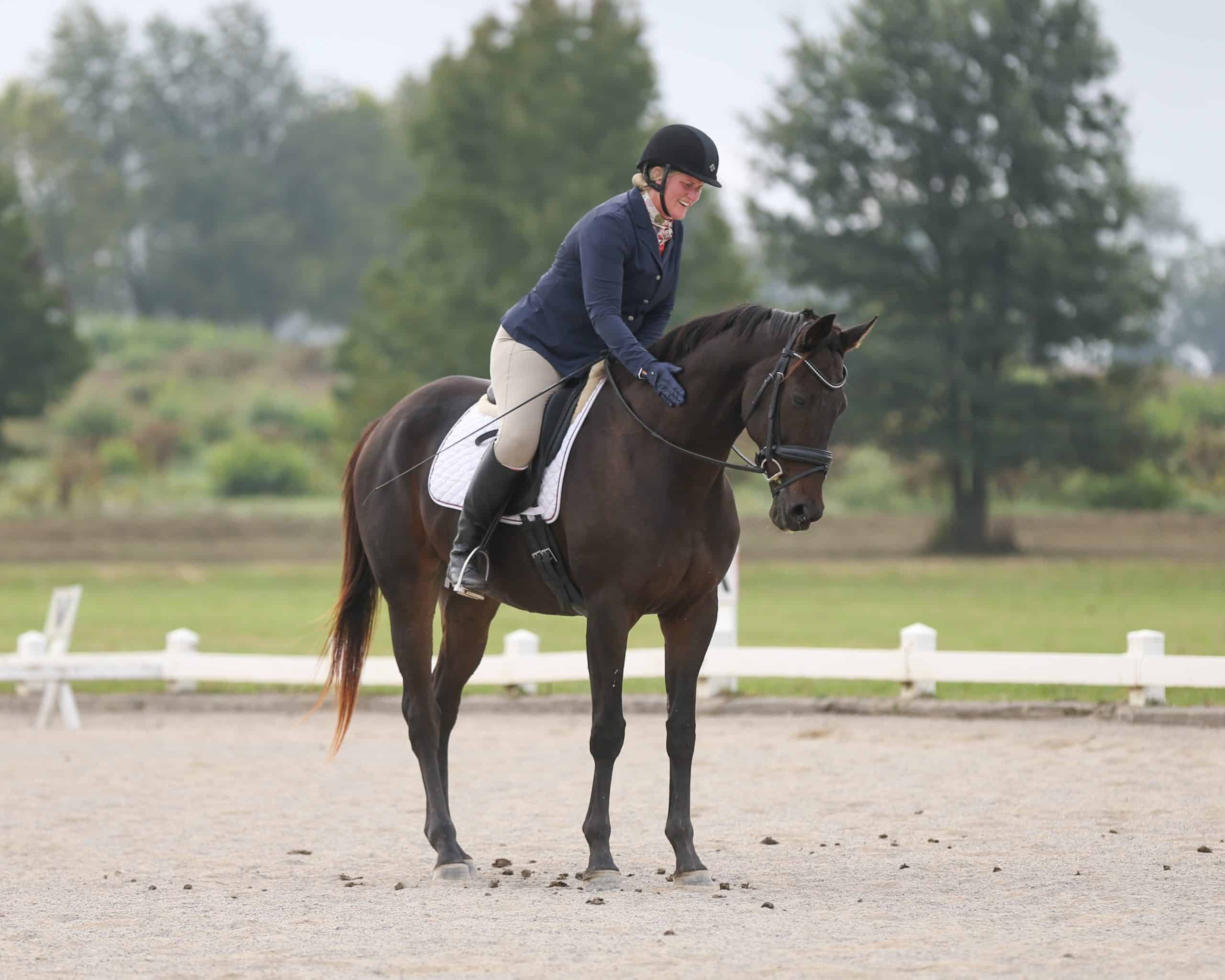
When Dr. Dionne Benson isn’t busy ensuring racehorses at 1/ST Racing’s tracks have the safest environment possible, she’s competing her own OTTBs in eventing.
Photo by CanterClix
Dionne Benson, like most competitors, prefers to take her horse into a show arena right after it’s been dragged. The more horses that have gone over a course — whether they are negotiating a series of jumps or performing a dressage or reining pattern — the more chances for a misstep.
“The minute one person goes over it, it changes that surface for that next rider,” says Benson. “It’s never going to be the same ride twice unless you’re resurfacing the facility between every rider, which no one can do.”
Benson, who is based in Kentucky, competes in eventing with her off-track Thoroughbreds during her leisure time. She doesn’t get much free time, however, because professionally she is Dionne Benson, DVM. Her job as chief veterinary officer for 1/ST Racing consists of making sure racehorses at the company’s tracks around the country have the safest environment possible.
Unlike horse show venues, racetracks typically do maintain their surfaces between every “ride.” After each race, out come the tractors, harrowing and watering the entire track before the horses in the next race take their places in the starting gate. Large tracks have entire crews, headed by a track superintendent, who are responsible for maintaining the best surface possible.
But racetrack safety means much more than renovating the track. That track surface must be scientifically examined from top to bottom to be sure its components are ideal for everything from weather conditions to the amount of traffic going over it daily. Horses need thorough and frequent examinations to be sure they are sound for racing and training. And rigorous testing, even among horses in training and not yet ready to race, must be done to assure all competitors and the public that only approved medications are being used and in the proper amounts.
Santa Anita, one of the racetracks owned by 1/ST Racing, is a classic example of how safety measures can work. In 2019, during a particularly rainy winter, the Southern California track experienced a devastating number of equine fatalities that received nationwide scrutiny.
Management worked closely with its track superintendent to improve the track surface. Santa Anita instituted several new policies for overseeing racehorse soundness, and among its changes was the creation of Benson’s position. Everyone pitched in, she says, including the trainers, horse owners, jockeys and grooms, and the 2022 Santa Anita season resulted in the safest on record for a North American racetrack with a comparable volume of racing and training. Santa Anita in 2022 improved 74% from 2019 and 62.5% from the 2021 winter meeting.
Santa Anita’s experience demonstrates policies each track can implement to make racing safer. The federal government is beginning to regulate safety on a national level through the newly established Horseracing Integrity and Safety Authority (HISA).
HISA, created through the Horseracing Integrity and Safety Act signed into law in 2020, includes a racetrack safety program, which went into effect July 1, 2022, and an anti-doping and medication control program, which is scheduled to go into effect in January 2023.
Benson, who previously served as the executive director and chief operating officer of the national Racing Medication and Testing Consortium, says she is devoted to increasing the safety at 1/ST Racing tracks around the country. She also wants to serve as a resource for HISA in developing its regulations because, for her, it’s all about keeping the animals we love as safe as possible.
One of the key ways she and her colleagues have done that at Santa Anita is through training oversight.
“I think getting a bigger handle on training has certainly changed things,” says Benson, “whether it’s veterinary oversight by the racetrack, private veterinarians examining horses before they work, controlling medication in training or eliminating the use of the whip in training.”
Racehorses receive much more scrutiny today at Santa Anita than previously. Before they work at speed in training, they are subject to more veterinary examinations. All horses receive a pre-race veterinary exam the morning of their races, but now more vets look at them, and a panel weighs those reports and a host of other variables before deciding whether each horse can race. If the panel decides it is in the best interest of the animal for that horse not to race, the horse is not allowed to compete.
“Instead of just providing the surface, we really focus on the horse,” Benson says.
Benson notes that Santa Anita’s management and maintenance crew also spend more time examining the track surface. If they do not feel it is optimal, they will close it for training. They are taking into account not only how that surface could impact a horse that day but also how training on the surface might affect horses’ future soundness.
“When we have a really rainy day, it’s never that day; it’s two weeks later that we start to see issues,” says Benson.
Research on racehorses has shown catastrophic injuries often happen because of microfractures that occur much earlier in a horse’s training or, as Benson explains, “most injuries are cumulative.” Santa Anita in conjunction with organizations such as California Thoroughbred Trainers (CTT) now has a host of advanced diagnostic equipment, including a standing MRI unit and a PET scanner in addition to nuclear scintigraphy (bone scan). CTT has instituted continuing education for trainers and all backstretch personnel, with videos on such topics as training 2-year-olds, lumbar injuries and neurologic conditions.
Racing rule changes are occurring as well. HISA has already adopted a similar rule to one California adopted several years ago regarding claiming horses. Claims for a horse are always put in before a race, with the new owner getting the horse no matter how he performs. That used to include occasions when a horse had an injury, but now the California regulatory body voids any claim if the official veterinarian deems that horse to be sore.
Each state that conducts horse racing has its own regulatory agency, with its own rules. That can lead to confusion as well as a competitive disadvantage. If a state like California has strict soundness requirements, someone with a horse that doesn’t qualify to race there could go to a more forgiving state.
This is where HISA could help the entire industry. By establishing national standards, HISA could ensure a level playing field for everyone. Horses will benefit because stricter rules will be in place everywhere to assure equine safety, Benson says.
Such safety measures can even affect the availability of off-track Thoroughbreds. In some cases, Benson says, horses are going to second homes earlier and sounder because these safety measures are determining racing isn’t the ideal career for an animal that might never even get to the races. In other cases horsemen are learning how to keep racehorses sounder, she says, resulting in longer racing careers. Some of those horses aren’t reaching the secondary market until later in their lives.
Despite Santa Anita’s progress, Benson says she sees her role as just beginning. For example, now that officials have confirmed the amount of fetlock injuries has decreased, she would like to focus on long-bone fractures.
“Fractures of this type have a very specific pattern,” she says. “These are horses coming off a long layoff, 90 days or more.”
A horse is more likely to suffer this type of injury when he is asked for his first gallop after returning from such a layoff. Research is needed, she says, to determine which horses might need scintigraphy, which has long been available at Santa Anita, though it can be expensive.
“These are 100% preventable if you have a diagnostic bone scan,” Benson says.
Another topic on Benson’s wish list, she says, is more research into how many high-speed furlongs over time are too much for each horse. Such research might indicate horses completing X amount of high-speed work over X amount of time should be required to have specific diagnostic tests.
While some equine injuries are unavoidable, many can be prevented. Benson wants to ensure all racehorses stay sound so they can have their best racing careers. And when they are finished racing, she is one of many people looking to give them terrific second careers.
This article was originally published in the Fall 2022 issue of Off-Track Thoroughbred Magazine, the only publication dedicated to the Thoroughbred ex-racehorse in second careers. Want four information-packed issues a year delivered to your door or your favorite digital device? Subscribe now!

